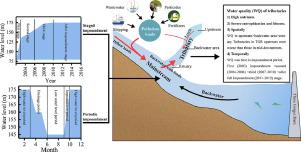Water Research ( IF 11.4 ) Pub Date : 2021-03-02 , DOI: 10.1016/j.watres.2021.116993 Rong Xiang , Lijing Wang , Hong Li , Zebin Tian , Binghui Zheng

|
The Three Gorges Reservoir (TGR) underwent staged impoundment during 2003−2010. Periodic water impoundment included drainage (March to early June), low water level (June to August), impoundment (September to October), and high water level (November to February) periods. However, the impacts of the Three Gorges Dam (TGD) and impoundment on water quality of TGR tributaries remain poorly understood, especially in the long term and across the entire TGR drainage basin. Herein, water quality and hydrological indices of 27 tributaries, eutrophication of 38 tributaries, and pollution load of the TGR were determined during 2000–2015 to explore spatiotemporal variations in water quality. The results revealed slower flow velocity in tributaries and an extended residence time with the water level rising, and the water quality of tributaries was mainly affected by the mainstream backwater movement. Water quality was good in more than 60% of tested sites, had the best condition in the impoundment period, and it increased over time. Spatially, water quality in tributary upstream was better than in the backwater area, and worst in the tributary estuary. Among water quality indices, total nitrogen (TN) and total phosphorus (TP) were the key pollution indices, with median range of 1.619−2.739 and 0.088−0.277 mg/L, respectively. Additionally, water quality indices of TGR tributaries displayed temporal and spatial heterogeneity due to different hydrodynamic and pollution load conditions. A total of 38 tributaries displayed eutrophication, the frequency of blooms concentrated in spring and increased from the upper tributaries to the downstream area. These results expanded the theory of hydrodynamic variation and the associated evolution of the water environment after impoundment, could provide theoretical references for water quality management in river-type reservoir.
中文翻译:

2000年至2015年三峡水库支流水质变化
三峡水库(TGR)在2003-2010年期间分阶段蓄水。定期蓄水包括排水(3月至6月初),低水位(6月至8月),蓄水(9月至10月)和高水位(11月至2月)。但是,三峡大坝(TGD)和蓄水对TGR支流水质的影响仍然知之甚少,特别是从长期和整个TGR流域来看。本文确定了2000年至2015年期间27个支流的水质和水文指数,38个支流的富营养化以及TGR的污染负荷,以探讨水质的时空变化。结果表明,随着水位的升高,支流流速降低,停留时间延长,支流的水质主要受主流回水运动的影响。在超过60%的测试地点,水质良好,在蓄水期间条件最佳,并且随时间增加。在空间上,支流上游的水质要好于回水区,而在支流河口最差。在水质指标中,总氮(TN)和总磷(TP)是关键的污染指数,中位数范围分别为1.619-2.739和0.088-0.277 mg / L。另外,由于不同的水动力和污染负荷条件,三峡河流域支流的水质指数显示出时间和空间异质性。共有38个支流出现富营养化,水华的发生频率集中在春季,并从上支流向下游增加。











































 京公网安备 11010802027423号
京公网安备 11010802027423号